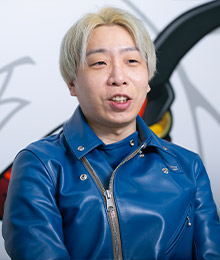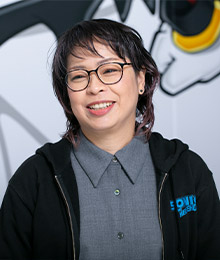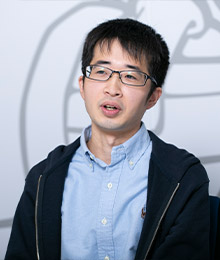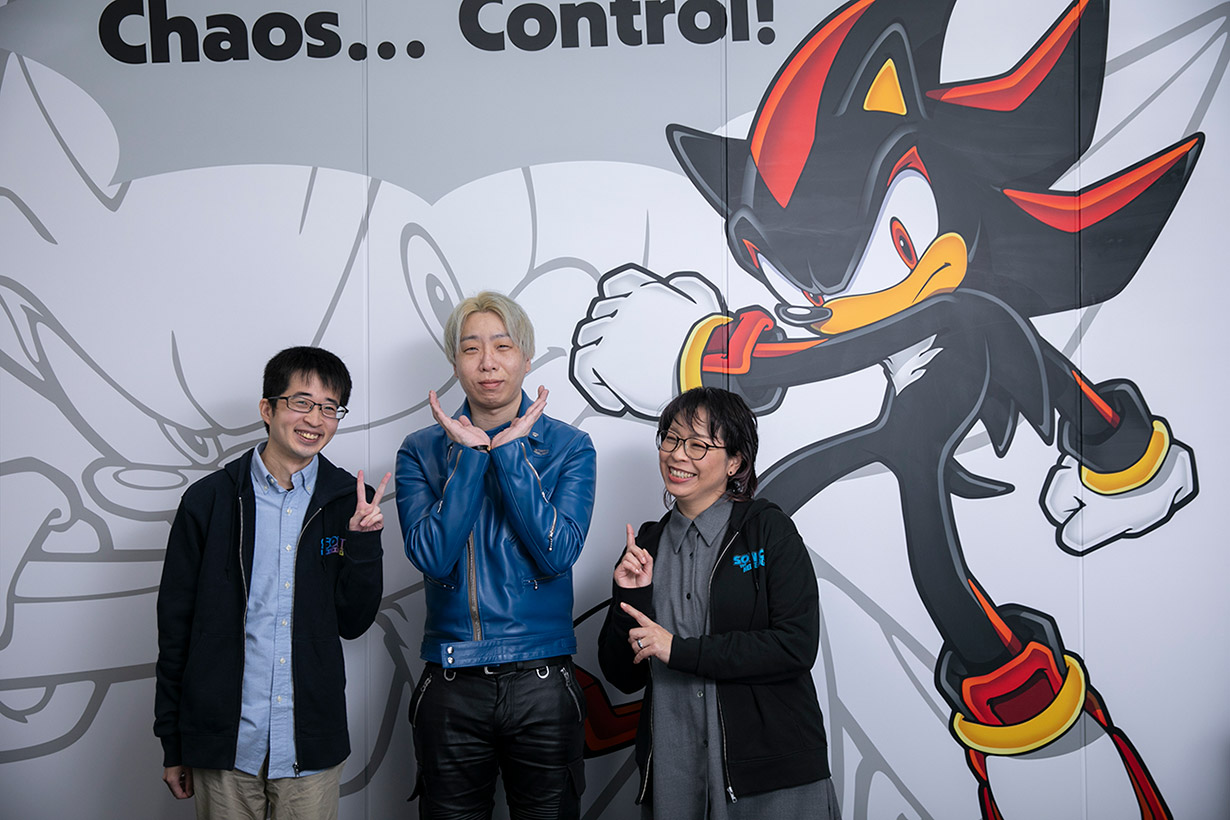"Sonic Frontiers" released worldwide in November 2022 as the franchise's first outing with open world gameplay—and proved quite the challenge to develop. The team members who worked on this project shared behind-the-scenes insight on the difficulties they faced in this unprecedented project.
The Game Making Process

"Sonic Frontiers"
Developer Interview
MEMBER PROFILE

Sub Lead Game Designer Masaya Hirano
Joined in 2014.
Previously worked as a Game Designer on the development of Mario & Sonic at the Rio 2016 Olympic Games and Mario & Sonic at the Olympic Games Tokyo 2020 before becoming the Sub Lead Game Designer of "Sonic Frontiers".

Sub Lead Field Artist Yuki Takahashi
Joined in 1998.
Previously worked as the Sub Lead Field Artist on the development of "Sonic Forces" and "Sonic Lost World". Also served as the Lead Field Artist on "Sakura Wars". Serves as the Sub Lead Field Artist on "Sonic Frontiers".

Lead Puzzle Programmer Yuki Mitsuishi
Joined in 2019.
Previously worked as a Programmer on the development "Mario & Sonic at the Olympic Games Tokyo 2020" before becoming the Lead Puzzle Programmer in "Sonic Frontiers".
When you were assigned to work on "Sonic Frontiers", what kind of hopes or expectations did you have?
My mission was to turn Sonic into a franchise that could compete against other global blockbusters. With this in mind, my goal was to raise the bar and kickstart a brand-new generation of titles that'd completely redefine Sonic. Despite having worked on "Olympic Games Tokyo 2020 – The Official Video Game", I could feel the excitement that came with developing a new open world game.

I've worked on Sonic games for years, so I've had experience approaching development from a global standpoint. However, I knew that this would be a challenge when I learned it would be our first global release on multiple platforms—with open-world gameplay, to boot. Having said that, we'd come this far by overcoming new challenges on each project together, so I knew this wouldn't be any different.

I was placed on the "Sonic Frontiers" team soon after arriving at SEGA. Since I'd joined the company part way, I had limited exposure to the franchise compared to other team members, so my journey began by getting a grasp of where we were going to take Sonic. Putting together Sonic Frontiers' open-zone* gameplay was a massive undertaking, and I felt a bit nervous wondering how we could pull it off. In spite of my hesitations, there were many veterans on the team who'd previously worked on Sonic, and they were a massive help.

*In traditional action games that are focused on reaching a certain goal, you traverse through a "world map." In Sonic games, the "worlds" are referred to as "zones."
Could you tell me about the structure of your team and what kind of roles you took on?
Initially, my main duties as a game designer were making the specifications and designs for the game's levels. Over time, my role expanded into that of the sub lead game designer. I performed quality assurance checks of my team's work and was in charge of almost all of the action aspects of the game. There were around 20 game designers on the Development team. Another 120 team members contributed to the team as well, including artists, programmers, and sound engineers.
As a field artist, my chief responsibility was to make the objects that appear in the puzzles of each world. On top of that, I was a sub leader of the field artist team, which consisted of around 25 people. I'd organize and manage their schedules.
The programmers were split into different teams, each assigned to handle specific gameplay aspects. I led the team responsible for developing the puzzle content for each world.
The team's size fluctuated between four to seven members. My job was to monitor their progress and serve as a liaison between the game designers and artists. I was also involved with the implementation of certain story and minigame elements.
As you transitioned from making traditional linear levels to open-zone gameplay, how did development progress?
The hardest part was trying to wrap our heads around what open-zone gameplay would entail and what we could add to make it entertaining. Ultimately, it's an action game, so the only way of knowing if it's any fun was to play it. We considered what would be fun and faithful to the series, and then tested our ideas through trial and error.
This project took roughly five years to complete. In its first year, a small team was tasked with finalizing the game's specifications. Back then, I was on a different project. The prototype build at the time wasn't up to par in terms of graphics or gameplay. The team had been using the Hedgehog Engine, a game engine tailored specially for the Sonic series. However, as we made headway into the development of "Sonic Frontiers", we found that we needed to add new features in order to construct its open-zone gameplay. There was a sense of urgency—everyone was desperate to create something innovative and didn't want the project to fail.
The open-zone gameplay revolved around solving puzzles at first. However, the game designers came up with numerous ideas to make the game even more fun. As we implemented these suggestions, we'd adjust the gameplay based on the feedback we'd get. We ended up changing much of the game. During the prototype phase, programmers would add their own features to builds and present them to the game designers. Some of them were included in the launch version of the game.

Once we moved past the prototype phase, we kicked things into high gear. We created an open-zone island that was three times bigger than Kronos Island (the island that Sonic arrives at in the beginning of the game) and covered it with all kinds of puzzles. The rotating statue puzzle from the beginning of the game was one of these puzzles. While the puzzle aspect brought a refreshing touch to the series, the game lacked the high-speed action that had become synonymous with Sonic.
We became so engrossed in creating puzzles that we lost sight of Sonic's main draw. When a programmer who'd been with us for three years proposed a way to generate grind rails, we began to make headway. We made major changes to the battle and puzzle-solving aspects of the gameplay so that we could weave in more Sonic-like gameplay elements and allow players to have fun while exploring the game's world. This led to the version of the open-zone gameplay that you see in the final game.
Many team members voiced concerns about seeing the same scenery throughout the island, so we decided to completely revamp the background design from the ground up and made huge changes. An open-world game requires a different sensibility than traditional action games. We had to make sure nothing stuck out no matter where you looked. In addition, we added a day-and-night system and weather effects. We've reached an uncanny level of realism in "Sonic Frontiers". In our pursuit realism, we dedicated significant effort to creating exciting landmarks and unique locations that could only be found in a video game. We broke up into specialized teams dedicated to reproducing realistic objects and landscapes such as ruins, rockscape, and foliage. This was the first time that the Sonic Team attempted anything quite like this.
What were some of the unique problems you faced in making a title for a global audience?
We found that what appeals to Japanese audiences doesn't always carry the same appeal for overseas audiences. In Japan, we wanted to promote the game using a serious visual tone to reinforce that "Sonic Frontiers" was unlike any of its predecessors. However, the North American market preferred a more traditional approach.
During the development process, we conducted multiple playtests in North America. Users who matched the target demographic would play the game; we ended up making countless changes based on their feedback. Playtests have always been part of the process, but never before have we conducted so many while making adjustments based on the feedback.
I watched their reactions in real-time. Afterwards, I'd immediately discuss their feedback with the director and implement improvements.
Yeah, we did get some pretty harsh review scores from our overseas playtesters. Watching the gameplay footage, it quickly became apparent what wasn't working out well. We noticed an uptick in the review scores once we improved those areas. Seeing a 6 get bumped up to an 8 was a huge source of motivation for me.
Our team remained motivated even when we scored low. There were aspects that worked well in past Sonic games, but we wanted to strive for something better. Essentially, my role was to assess whether the gameplay of the prototypes stayed true to the spirit of the Sonic series. Sonic games, at their core, are action platformers. Be it running or jumping, movement should feel fun and fluid, so this was our first and foremost priority.
We'd use the constructive feedback we received from negative playtest reviews to perfect the open-zone gameplay.
Eventually, our overseas playtesters gave out 8/10 and 9/10 scores. It then hit home that we'd finally found the right tone for the game.
Now that the project has been completed, how do you feel? What challenges would you like to take on next?
We achieved what we set out to do—"Sonic Frontiers" has gone beyond the traditional linear format, offering a panoramic experience with a much higher degree of freedom than ever before. There was definitely pressure to create a quality game that lived up to the brand. However, thanks to its positive reception, we've been able to go ahead and provide further updates to the game.
This was my first time working on Sonic. By the end, as the leader of the project, I was heavily involved with all action-based aspects of the game, and I felt that I had a much deeper understanding of the fundamentals of an action game. I'm excited to apply the insights I've gained from this experience to take this new generation of Sonic games to new heights and create more games that will be enjoyed by many.
Creating a new game world—ruins and all—wasn't easy work. However, I'd say for now, we were able to hammer out a new setting for Sonic going forward. We were able to delegate tasks among us based on our individual strengths and then put everything together as a team. Our rookie team members were able to polish their strengths and work on their weak points, so I really feel like we've leveled up across the board.
Although it's hard to break into the league of global AAA blockbusters, I'd like to aim for that level of graphic design.
With "Sonic Frontiers", we were able to show what this new generation of Sonic games is capable of. Developing open-zone gameplay for the first time was a challenge for us. This project was also a huge personal challenge for me, as it was my first time serving as a team leader on a project of this scale. However, it was invigorating to challenge ourselves as a team to create an entertaining Sonic game. Having the opportunity to shape the story and the game as a whole was also a valuable experience for me. One day, I'd like to pursue my dreams and tackle an even more ambitious project than "Sonic Frontiers".
Could you say a few words for prospective applicants to SEGA and what the unique merits of working there are?
The staff members who'd only been with us for a few years were the stars of this project. SEGA's strength lies in its ability to provide a strong platform for young employees to develop. Through a range of opportunities, they can assume important players and work closely with seasoned veterans.
I was involved in the development of our in-house Hedgehog Engine as the main point of contact for our artists. Seeing SEGA's strong commitment to its artists firsthand and its continuous efforts to improve engines based on their feedback make it an exceptional working environment. With state-of-the-art technology at your disposal, you have the freedom to push yourself and take on any challenge. Furthermore, if you're not sure how to achieve your targets, your superiors are always willing to offer you a helping hand. There have been instances where individuals were given the chance to switch from background production to character production. It's rare to find companies in the gaming industry that offer the flexibility to change career paths.
Here you have the opportunity to implement a wide variety of different game features, including enemies, UI, controls, or even stage behavior that appear in levels. There are also many chances to work hands-on with technical aspects of game production as we branch out to other gaming platforms. Plus, since we make our own game engines as well, we can fine-tune them according to the unique demands of each title. At SEGA, we believe in open communication and highly value the interests of our team members. Whether you have a specific project in mind or you're simply enthusiastic about different fields of game development, SEGA provides the ideal atmosphere to enhance your skills and pursue your passions.

MAKING









